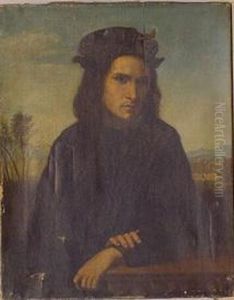Franciabigio Paintings
Franciabigio, whose real name was Francesco di Cristofano, was a prominent painter during the High Renaissance period, born in Florence, Italy, in 1482. He is recognized for his contribution to the Florentine school of painting, and his works are characterized by their clarity of form, serene composition, and the influence of his contemporaries, such as Raphael and Andrea del Sarto, with whom he frequently collaborated.
Franciabigio began his artistic training under the guidance of Mariotto Albertinelli and possibly also spent some time in the workshop of Piero di Cosimo. His early works display a combination of influences from various Florentine artists of the time, including Albertinelli and Fra Bartolomeo. Franciabigio's style developed as he incorporated elements from these masters, eventually achieving a distinctive approach that blended precise draftsmanship with a softer, more graceful touch.
In 1509, Franciabigio formed a professional partnership with Andrea del Sarto, and together they executed a series of important commissions, notably frescoes for the cloister of the Scalzo in Florence, depicting scenes from the life of John the Baptist. This collaboration proved to be a significant period in Franciabigio's career, as he absorbed del Sarto's harmonious coloring and compositional techniques, which he would later adapt in his own paintings.
One of Franciabigio's most famous works is the fresco 'Marriage of the Virgin' (1513) at the Annunziata Basilica in Florence, which illustrates his ability to create a harmonious and balanced composition, with a clear influence of Raphael's work. However, Franciabigio's temperament was known to be quite volatile, and it is said that he was so dissatisfied with onlookers peering at this fresco before it was finished that he marred the Virgin's face with a brush stroke in a fit of anger.
Throughout his career, Franciabigio also produced a number of portraits that exhibit his keen attention to detail and psychological insight. His portraiture, while not as prolific as his religious compositions, demonstrates a depth of character and a subtlety in the rendering of his subjects’ features.
Franciabigio's life was relatively short; he died in 1525 at the age of 43. Despite his premature death, his work left a lasting impact on the world of Renaissance art. His paintings continue to be admired for their blend of technical skill, compositional elegance, and a quiet, yet profound, expressiveness. Franciabigio's legacy is also evident in the works of later Florentine painters who were influenced by his approach to painting and his integration of the High Renaissance style into the fabric of Florentine artistic tradition.
